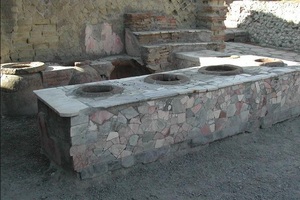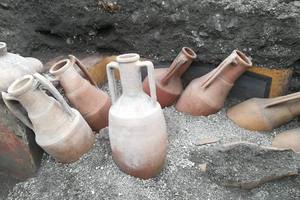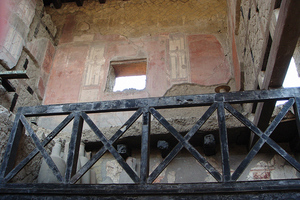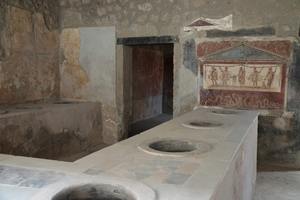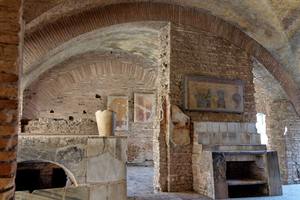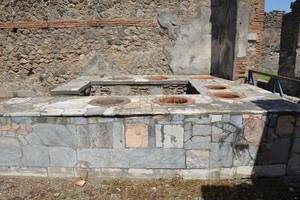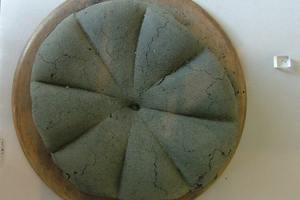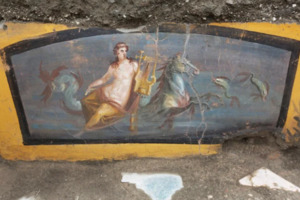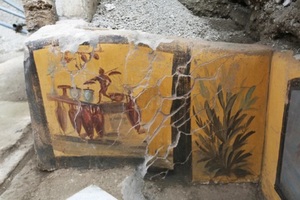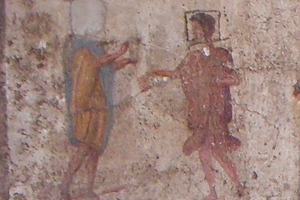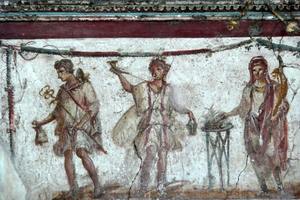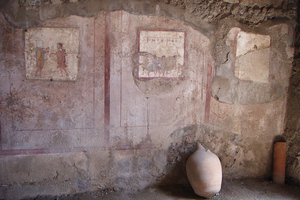Thermopoly
A thermopolium (Latin: thermopolium, from the Greek θερμός "warm" and πωλέω "to sell") was a type of ancient Roman snack bar or fast food establishment where hot food and spiced wine were served. It can be seen as an ancient equivalent of modern taverns, pubs, and bars.
Thermopolia were typically small establishments with counters opening directly onto the street. Food was heated using large jars or vats (dolium in Latin) embedded directly in the counter, somewhat resembling modern bar counters. The food was cooked and kept warm over fire beneath these containers. The dishes served at a thermopolium were likely very simple, such as peas, beans, and lentils. Hot water mixed with wine was also commonly offered. Customers could eat either standing or sitting.
In Pompeii, large and elaborately decorated thermopolia have been discovered, some even featuring seating areas and rooms for guests, similar to inns known as cauponae.
Thermopolia were widespread throughout the Roman Empire, with examples found in places such as Ostia, Herculaneum, and Pompeii.
Fast food in Ancient Rome
Fast food establishments in ancient Rome were primarily frequented by people of lower social classes (slaves, freedmen, sailors, porters, craftsmen, and day laborers). Juvenal also noted that these places were often frequented by bandits, thieves, runaway slaves, executioners, and gravediggers who had no means to prepare food in their cramped living quarters, as well as by workers and travelers. Aristocrats who visited such establishments risked losing social respect, a fact that political rivals could exploit. Thermopolia, along with cauponae and popinae, served not only as places to eat but also as social hubs where people gathered for leisure and conversation. These places often featured gambling, performances by dancers and singers, and were popular among regular patrons. Owners often advertised their establishments with promoters and colorful frescoes at the entrance.
Bars and snack bars filled up mainly in the evening and stayed open until late at night, although many were also open during the day, especially those near baths or other high-traffic areas.
In taverns, wine was served, and in Gaul, beer as well, along with olives or other snacks. Popinae served peas, beans, onions, cucumbers, eggs, cheese, seasonal fruits, some meat dishes for wealthier customers, pies, and pastries. Some emperors attempted to limit the variety of foods served to curb "luxury" and maintain traditional values, urging citizens to cook hot meals only at home. Thermopolia were also seen as potential gathering places for discontented groups. For instance, Tiberius banned the sale of bread and pastries, Nero prohibited the sale of "cooked food except for vegetables and greens," and under Vespasian, only beans were allowed to be sold.
In Pompeii, numerous thermopolia and popinae—small eateries with street-facing counters—have been excavated. These establishments featured deep jars where pots of food were kept. Behind the counter were shelves with wine amphorae, along with tableware and kitchen utensils. Such establishments included a stove or hearth where a pot of warm water hung, allowing visitors to dilute wine or drink plain water. Wealthier patrons could enjoy roasted meat prepared over the hearth. Larger thermopolia also had storage rooms and a guest room, which could be quite lavishly decorated with frescoes and furniture. These rooms often served VIP clients.
Related topics
Thermopolia - club activity, Popinae, Caupona
Literature
- Uletova Yu. Thermopolium — an antique Pompeii eatery. "Pompeii: step by step", nplus1.ru (02.04.2019).
- Weeber, Karl-Wilhelm. Alltag im Alten Rom: ein Lexikon. — Zürich: Artemis, 1997. — ISBN 3-7608-1140-X.
- Suetonius. Life of the Twelve Caesars
- Juvenile. Satires
